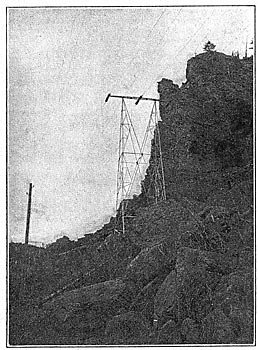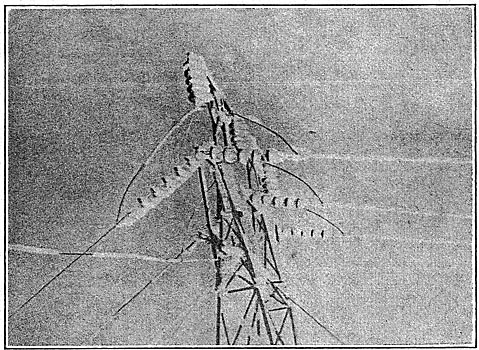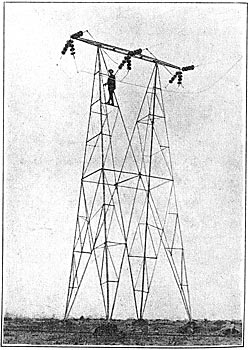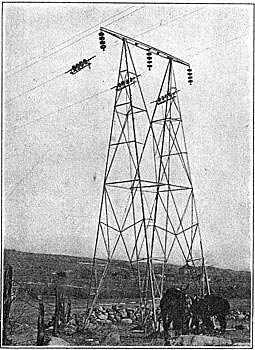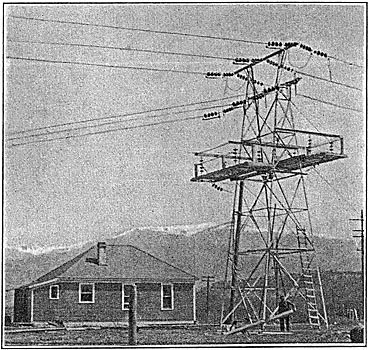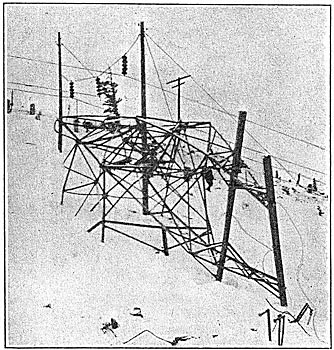[Trade Journal]
Publication: Electrical World
New York, NY, United States
vol. 59, no. 22, p. 1205-1208, col. 1-2
A 100,000-VOLT TRANSMISSION ON
THE ROOF OF THE CONTINENT.
Operating Methods of the Central Colorado Power
Company's System—Lines in Mountain Passes at
Elevation of 13,628 Ft., Where at 59 Deg. Below
Zero Winds Blow 165 Miles per Hour.
FROM the Shoshone water-power plant into Denver, 155 miles distant, the 100,000-volt transmission line of the Central Colorado Power Company three times crosses the Continental Divide, reaching a maximum altitude of 13,628 ft. in the famous Argentine Pass, where wind velocities have been recorded higher than 163 miles per hour, where the mercury drops to 59 deg. below zero in winter, and the snow, sometimes 30 ft. deep, blocks the pass until August. Coupled with the high wind velocities come severe sleet and snow storms, often caking the insulators and conductors into solid masses, while in the summer months the lines are subjected to some of the most severe lightning seen in any locality on the continent.
| |||
| Fig. 1 — Standard Transmission Tower, Showing Character of Country Traversed. |
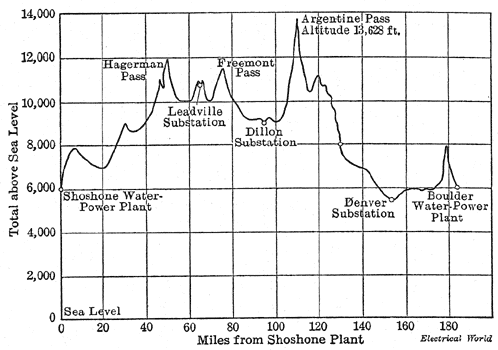 |
| Fig. 2- - Profile of Transmission Line of Central Colorado System. |
At Argentine Pass, where the transmission line rises 13,628 ft. above sea level, probably the highest point to which any electrical circuit in the world is carried, five desolate canyons unite their blasts to produce wind velocities almost unbelievable. The only wind gauge ever installed in the pass to indicate these velocities pointed to 163 miles an hour and was then itself blown away. A specially prepared board, 12 in. square, suspended by a 50-lb. spring balance, was next experimented with in order to get a basis for wind-pressure calculations, but the wind quickly wrecked this apparatus also, straining the pointer far past the end of the scale. To what limits the actual wind velocities attain in the pass can therefore only be guessed. Line patrolmen on the summit during storms have had to lash themselves to the anchored steelwork of the towers to prevent being blown away. One man's dog, not so fortunate, was actually picked up like a leaf by the blast and blown far out over the side of the mountain, never to be seen again. The winds which prevail on the pass are not steady in direction, but are known to reverse almost instantly from one to another of the canyons, so that structures and objects on the mountainsides must be braced and guyed from every direction.
100,000-VOLT LINE CONSTRUCTION.
This mountain-top line of the Central Colorado Power Company conveys hydroelectric energy from the 20,000-hp Shoshone plant in the Grand River Canyon near Glenwood Springs to the respective substations serving Leadville, Dillon and Denver. At the Denver substation, 2 miles from the city, the Shoshone line is joined by the transmission from the Boulder 20,000-kw plant, 28 miles north of Denver. The Boulder station operates under a hydraulic head of 1680 ft., and like the Shoshone plant was described in these columns at the time of its construction several years ago. The present article deals only with the unusual transmission equipment of the company and the departures from ordinary practice which have resulted from three years' operating experience under conditions equaled in severity probably nowhere on the face of the globe.
No part of the Central Colorado system is less than a mile in altitude, while at the passes where the divide is crossed the elevations are between 2 miles and 3 miles above sea level. As the result of the diminished air pressure, the corona limit for the No. 0 seven-strand hemp-center copper conductor used is very nearly 100,000 volts, so that the system is actually operating nearer its critical point than are other lines employing a higher pressure in lower altitudes. The altitude factor alone may not be accountable for all of the lowering in corona point observed in the Colorado system. The Shoshone circuit traverses one of the principal pitchblende deposits known, which is mined for the recovery of uranium, radium and other radioactive materials. Since, according to modern views, corona and atmospheric conduction depend upon the ionization of the air set up by radioactive materials in the earth, it seems probable that in the midst of such large radioactive deposits the rapidity of ionization would be increased, similarly increasing corona effects and tending to lower the critical corona voltage.
TROUBLES DUE TO GROUND WIRES.
The standard construction of the Central Colorado lines consists of three No. 0 seven-strand hemp-center copper conductors carried in the same horizontal plane, at 11-ft. distances, by General Electric four-disk suspension-type insulators, each 10-in. disk having been tested to withstand 90,000 volts. Five-disk insulators are now being installed in all new work, and by an additional mechanical link the distance between disks is being increased from 8 in. to 10 in., increasing the break-down strength of the string. The 42-ft. steel towers, built by the Riter & Conley and Millikan companies, are ordinarily set seven to the mile, making an average interval of 750 ft. between towns. This distance is varied considerably, however, depending on the topography of the country. The longest span on the system measures 2900 ft.
From the horizontal cross-arms of the towers, at points midway between the insulators, ground wires were originally installed. These wires, of 1/4-in. Siemens-Martin steel, were pulled as taut as possible, but much trouble has been experienced from the line conductors swinging against, as well as clear over, the ground wires. The peculiar winds to which the line is subject exert a remarkable lifting effort on the wires, blowing them sometimes upward as well as sidewise, so that the main conductors have been found actually looped over the ground wires. As the lines are subject to these severe winds during eight months in the year and to lightning barely four, and since thunderstorms are usually accompanied by high winds, it is now suspected that the ground wires are the cause of more trouble than they prevent, even the hitherto supposedly pure lightning troubles being partly credited to swinging contacts between the wires. Except on the passes and exposed sections of the lines, the ground wires are accordingly now being removed altogether, while in the places where some lightning protection still seems imperative only one ground wire is allowed to remain, and this is being elevated 4 ft. above its former position on the cross-arm, so that it will be well out of the way of any swinging of the line conductors.
DEPARTURES FROM STANDARD CONSTRUCTION.
Besides the usual tower construction, many extraordinary departures have had to be adopted in carrying the line across the rough, wild country it traverses. Entering one deep canyon, 8200 ft. wide, the wires are carried from insulators hung on steel messengers strung between the rocky walls into which their anchors are cemented with melted sulphur. Sulphur expands on solidifying, thereby making a firm joint. In other places, to secure enough clearance on short turns, towers are guyed to nearby rocky walls and one or two of the conductors are hung, as before, from these span wires. On the passes steel cable replaces the copper conductor and is extended down both sides of the mountain out of the region of high wind and sleet. All towers on these wind-swept sections are firmly guyed to sulphur-set steel anchors, two back, two forward and two at the sides. The tower legs are bolted to 12-in. I-beams set deep in the rock. Every possible precaution has been taken to add strength to the construction, for under the combination of cold, sleet and wind the mechanical stresses set up in these inaccessible structures are almost unbelievable. After sleet storms as much as 2 lb. of ice has been scraped from a single foot of conductor, and sleet coatings on the wires have been measured 6 in. in diameter. An accompanying illustration of one of the towers at the crest of the Argentine Pass shows how solidly this ice and sleet is plastered over insulators and conductors from the lower or windward side. Upon this added ice surface let a 59-deg.-below wind blow at 150 miles an hour, and the surprise, indeed, is that steel can withstand such punishment. Several towers have been buckled and demolished during storms by the sheer wind striking the conductors, without ice or sleet to aggravate the trouble.
| |||
| Fig. 3 - Sleet on the Crest Tower of Argentine Pass, Elevation 13,628 Ft.. |
In places about the passes snow collects to a depth of from 30 ft. to 35 ft., burying the telephone wires and even dragging the main conductors. This snow does not disappear until August, and for nine months in the year the right-of-way is impassable.
EMERGENCY LINE AT SUMMIT OF PASS.
To insure continuity of service in case of break-down a duplicate emergency line is therefore provided over the most dangerous part of the Argentine Pass, a distance of 3 miles. This emergency line is tapped to the main circuit with air-brake knife switches, similar to the disconnecting switches used throughout the system. If the main pass line goes down, the patrolmen on each side can get to these transfer switches and thus put the auxiliary line into service until the break can be reached the following season.
LOCATING TROUBLE WITH SECTION SWITCHES.
The use of emergency disconnect switches to break up the line for test purposes has been found to be of the greatest convenience in locating trouble. At intervals of from 3 miles to 5 miles, depending on the contour and character of the country, these disconnect switches are inserted as shown in Fig. 4. The switch itself comprises simply a 48-in. double blade closing across a standard strain insulator acting as a breaker in the line wire, which is dead-ended into its eyes. When closed upward into place the blade is locked into its clip by a spring latch. The switches are operated from the towers by means of a wooden stick having a grounded chain connected above the operator's handle. Each switch tower is provided with such a stick, the chain being held clear by suspending it in a vertical pipe on the tower. To avoid the always-present human element of neglectfulness to ground the chain to the tower, many of the switch towers have insulated or wooden platforms for the man to stand upon. Many of these switch towers are near line patrolmen's headquarters, while others are on ranches where someone can be instructed by telephone to open the switch if necessary. The ranchman receives $5 for assisting in a test of this kind.
| |||
| Fig. 4 — Emergency Breaker-Switch Tower. |
If a line is discovered to be crossed or grounded, the chief operator of the system sends out a general order to open all disconnect switches. As soon as the first one has been opened, which may perhaps be the fifth or the fifteenth on the line, the operator tests the line by charging. If the nearby section shows clear, the first man is then instructed to close his switch, as the trouble is evidently beyond him. The next patrolman who can be raised is then ordered to open his switch, and the charging current is applied as before. In this way the trouble can be located in a single test section of line, and as soon as this is known the two patrolmen walk toward each other until the trouble is found and they meet and repair it.
| |||
| Fig. 5—Transposition Tower With Copper-Cable Jumpers in Galvanized Pipe. |
In the case of a difficult "open circuit," where a wire had burned itself clear and was hanging in the air, the dispatcher had exhausted all ordinary means of locating it and finally instructed each of his patrolmen to take a piece of No. 14 copper wire, bell wire, fuse wire, barb fence, or anything he could lay his hands on, and ground the affected phase wire to the pole. With the line sectionalized at the first switch, this phase wire was charged until patrolman No. 1 saw his improvised wire filament turn dull red in the dark. Thereupon he reported to the operator that the open must be beyond him and, removing the wire, closed his switch. The same operation was gone through at other switches, until the nearest one to the station which could not redden its wire was proved to mark the defective section. Once located the repairmen started to walk toward each other as before, soon finding and fixing the break.
EMERGENCY HOUSES WITH REPAIR PARTS.
At intervals of 2 miles to 3 miles along the line are little emergency houses built beneath the towers. Each house, with double-boarded walls and measuring 5 ft. x 5 ft. in plan, contains a full complement of emergency equipment for making any ordinary line repair, including tackle, spare conductor, ground wire and telephone wire, insulators, steel cable, sleeves, bolts, nuts, clamps, etc., besides an oil stove and sufficient canned food to sustain a man several days in case of storm outside. There is also a telephone connecting with the company's private circuit on a separate wooden pole line. On the poles at half-mile distances throughout the length of the system there are also iron-box weatherproof telephone sets from which the patrolmen can report at frequent intervals as they patrol their beats. A large part of the dispatching and forwarding of orders to operators and linemen is done by telegraph, over the telephone circuit. This form of auxiliary service proves especially valuable in case the telephone line is noisy or only one wire is available.
| |||
| Fig. 6 — Dead-End Switch Tower With Insulated Platform. |
In addition to the emergency houses along the line, there are larger shacks, each containing four bunks and four days' rations, at the crest of the pass and at the junction switch towers of the emergency line. Two patrolmen are employed on this section in summer and four in winter. The regular course for each pair, when the weather permits, is to cross the pass by way of the main line, returning along the emergency line, to insure the good condition of both.
A good trail is maintained alongside each line throughout the entire system, and every patrolman is required to go over his section at least twice a week, and once after every storm. And this means, by the way, that he cannot wait to let the storm abate before setting out. Every patrolman must provide himself with a horse for use in the lower levels, although, of course, after the tree line is passed, snowshoes are practically the only means of locomotion.
USE OF BINOCULARS FOR LINE INSPECTION.
Each patrolman is also supplied with a good pair of 12X binoculars, which are used to the greatest advantage in examining the lines for faults, both developed and incipient. By the aid of the glasses a man can examine his lines closely without climbing each tower. In the same way, of course, he can also detect a fallen wire at a distance reward.
CONSTRUCTION LESSONS OF OPERATING EXPERIENCE.
At the insulators the line conductors were formerly held rigidly in square-jawed clamps. It was soon noticed that many line spans would break directly at the insulators, or the strands would become cut and untwist, getting into various kinds of mischief. Careful study of the line during storms, with the aid of binoculars, soon revealed the fact that the swinging of the spans was causing twisting and cutting at the clamps, whose sharp edges bore against the copper. The old clamps are now being replaced with saddle clamps which do not hold the wire rigidly at the edges, and the former trouble has practically ceased.
The earlier jumpers used were of rigid tubing, bent in U form to bridge from dead-end to dead-end. This rigid construction also gave trouble and has been supplanted by jumpers made of the flexible line conductor itself. In case of very acute angle bends, the jumpers are anchored down by suspension insulators dropped from the same main arm, or, in other cases, are held vertically and rigid by insulators suspended from a special upper arm above the main arm.
Transpositions on the Central Colorado system are made by dead-ending the conductors to strain insulators and then completing the necessary cross-connections with cable jumpers of varying length, made rigid and of fixed shape by inclosing them in %-in. galvanized pipe. Here, it will be noted, the stranded cable is designed to be the conductor, the pipe merely serving as a rigid shaper.
REPAIR WORK AFTER A SNOWSLIDE.
Occasionally a snowslide on the side of some mountain flanking the valley with its transmission line sends tons of snow, ice, earth and miscellaneous material down against the towers, sometimes carrying away one or two and interrupting the service. As these slides usually occur in localities which can be reached only with the utmost difficulty, they are greatly dreaded, for almost no foresight in locating the right-of-way can avoid their damage. In December of last year a great slide near the Argentine Pass carried away three towers, one of which is shown crumpled up in Fig. 7.
| |||
| Fig. 7 — Tower Crushed by Snowslide, and Emergency Repair Construction. |
After testing, two patrolmen located the trouble to be on the pass and notified the line foreman to the east, who collected five men and started for the break. Meanwhile preparations were made from the other end, and a party was made up at Denver, including the chief engineer, line superintendent and linemen. By a circuitous railway route, the quickest under the circumstances, the party got to the pass approach the evening of the second day, and, on snowshoes, started on its 16-mile ascent into the pass, each member carrying 100 lb. or more burden of supplies.
The snow was 12 ft. to 15 ft. deep, and in setting the auxiliary poles shown the shovelers had to relay two levels to reach the frozen ground below. The poles were cut from the nearby telephone line belonging to the company, and a temporary span construction was improvised as shown, the conductors being hung from insulators. In other places bracket arms were erected. This temporary construction will have to stand until the midsummer of 1912 before the snow will have cleared sufficiently to allow the pass to be traversed by the regular line crew which will install standard towers.
The extraordinary charges of static electricity which collect on these highly insulated conductors when completely disconnected from any source of energy were well demonstrated during this job of emergency repair work. The wires were down on the snow in a tangled mass and one lineman attempted to pull them loose. As he grasped the wire nearest him he received a heavy shock which resulted in bad burns across each of the four fingers of one hand. Sparks 2 in. long have been drawn from the disconnected line, and the strength of these discharges seems to be almost unaffected by grounding or tying all the wires together at a point over a mile or two distant. The tie-chain or ground must be applied directly at the place where the workmen are to be protected, otherwise its presence is practically without results on the severity of shocks given by the static charge of the line. After having once been dissipated by a spark, this static charge is rapidly restored to the wire, which a few seconds later is ready to deliver another spark.
SYSTEM OF OFFICE RECORDS.
An elaborate system of photographic records is one of the most useful adjuncts in maintaining the operation of this 100,000-volt sky-high line. Every tower on the system is photographed and one or more views of it filed away in its numbered envelope. Usually there are several views taken from different angles, so that a good idea is available of all the wire clearances, surrounding country, etc., from the photographic record alone. If trouble has developed on a tower, a picture of this is also taken, as well as a view of the finished repairs.
In the office files there is thus made available a complete photographic record of every tower on the system. Then when a lineman telephones in and reports trouble on a given tower the chief engineer or his line superintendent can turn at once to the pictures of this tower, determine the kind of structure and the probable sources of trouble, and so give suggestions and instructions to the repairman regarding the work to be done, almost as well as if the superior were himself on the job. This photographic record is supplemented, of course, by detailed and complete maps of the line, showing every tower and division switch, the emergency houses, telephone poles, transpositions, etc.
Mr. E. M. Gilbert is chief engineer and assistant general manager of the Central Colorado Power Company, and Mr. V. M. McDonald is line superintendent.

